








If you’re anything like me, when you hear the word “evangelization,” you tend to immediately curl up on yourself and consider hiding under a table. The term can conjure images of mega-churches, religious pamphlets and people approaching me to talk about religion and make me uncomfortable. That’s not a great picture, I know.
But evangelization is more than pushy proselytization. It’s an invitation. And what’s more, that invitation comes in various formats. When you look at the writers, graphic artists, photographers and editors of this magazine, for instance, the word “evangelize” may not immediately come to mind. However, what is a Catholic magazine if not an invitation to learn more about God, our Catholic faith, and the people who live and share their faith everyday? Each cover of this magazine is selected with the purpose of sharing the beauty of our Catholic faith, and also of inviting you to open its pages. What’s more, if the content appeals to you, maybe you’ll share it with someone, invite them to learn more about Jesus.
While I am biased toward The Catholic Telegraph, many people evangelize in their own particular way through Godgiven gifts. When we started this issue, we looked for those who do just that. In several cases, those we contacted to write their stories protested that they aren’t evangelizers. So, we asked them to just talk about what they do and why they do it. Through interviews and conversations we confirmed that many are, in fact, evangelizers, but never connected that word to what they do.


Pope Francis shares why evangelization is so important in
his Apostolic Exhortation Evangelii Gaudium: “Of course, all of us are called to mature in our work as evangelizers. We want to have better training, a deepening love and a clearer witness to the Gospel. In this sense, we ought to let others be constantly evangelizing us. But this does not mean that we should postpone the evangelizing mission; rather, each of us should find ways to communicate Jesus wherever we are. All of us are called to offer others an explicit witness to the saving love of the Lord, who despite our imperfections offers us his closeness, his word and his strength, and gives meaning to our lives” (EG, 121).
Throughout the pages of this month’s issue, you’ll read about musicians, singers, football chaplains and even fundraisers— all of whom are evangelizing through their specific gifts. I hope that you connect with their stories, and perhaps discover ways you can share God’s love through your own gifts and talents.
Swensen
Easter Rising page 22
More Than Just a Game page 16
10 SHARING THE GOOD NEWS
KARY ELLEN BERGER
The Catholic Ministries Appeal
12 EUCHARISTIC MIRACLES OF THE WORLD BRICE BERGER
Blessed Carlo Acutis
14 SEIZE THE MOMENT
NICHOLAS HARDESTY
The “what” and the “why” of it all
7 QUESTION OF FAITH
FATHER DAVID ENDRES

Judas’ fate?
18 A CLOSER LOOK
DR. KENNETH CRAYCRAFT Benedict XVI and the New Evangelization
24 SHINE ON DOMINICK ALBANO Good News-ization
8 EUCHARISTIC REVIVAL
HARLIE GALLOWAY
All It Takes is a “Yes”
28 AEROSPACE IN THE CLASSROOM
BONNY VAN
St. Gabriel Consolidated School in Glendale Builds STEM Program with Support from the Civil Air Patrol
30 NATIONAL CATHOLIC MEN’S CONFERENCE
JESSICA RINAUDO
March 25 event to be packed with inspiration for men of all ages

33 ARCHDIOCESAN LENTEN FISH FRYS
ON THE COVER
PHOTO BY:
EMMA CASSANI
Rita Winters sings in the choir at the Church of the Resurrection in Bond Hill, Cincinnati.
16 MORE THAN JUST A GAME
JOHN STEGEMAN
St. Xavier students learn life lessons and make a lasting impact through team chaplain program
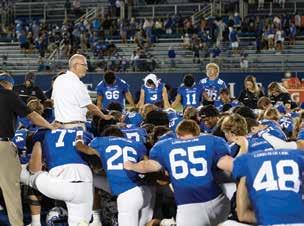
20 RESURRECTION CHOIR
ALLEGRA THATCHER
Through the eyes of one devoted member
22 EASTER RISING
EILEEN CONNELLY, OSU Art & beauty series
26 BRANDELL BRINGS FAITH BOOK TO LIFE
JESSICA RINAUDO Faith for kids
25 DID YOU KNOW? Assumption, Mt. Healthy
32 CATHOLIC AT HOME
KATIE SCIBA
Sacrifice in marriage
36 THEOLOGY OF THE BODY
DR. ANDREW SODERGREN Original Shame - part 2
38 KIDS’ CORNER St. Maria Josefa
40 OUT & ABOUT IN THE ARCHDIOCESE
42 THE FINAL WORD
CHRISTEN AQUINO Because He first loved us
POPE FRANCIS’ PRAYER INTENTION FOR MARCH
We pray for those who have suffered harm from members of the Church; may they find within the Church herself a concrete response to their pain and suffering.
Before ascending into heaven, Jesus instructed His disciples saying, “Go and make disciples of all nations, baptizing them in the name of the Father, and of the Son, and of the Holy Spirit” (Mt. 28:19). And, with the help and guidance of the Holy Spirit, they did just that. The disciples went out from Jerusalem and carried the message of the Gospel to all corners of the earth. The Church continues to follow Jesus’ command, and God calls each of us to share in that same mission.
The work of evangelization is not a responsibility belonging only to clergy or consecrated women and men. From the beginning, the Gospel has spread from person to person. Each of us has the opportunity to bring others to know Jesus and the Good News of our salvation through Him. In baptism we become partakers in God’s own divine life. Because of this, every aspect of our lives has the potential to be an avenue through which God’s grace can reach others. This means that we not only evangelize through our words; rather, all our actions and the decisions we make can also speak to the truths of the Gospel.
A life which radiates the Gospel is built upon prayer and virtue. We strive to follow the example of Jesus, staying united to the Father in the Holy Spirit and seeking to act as He did, fostering the qualities, attitudes and habits which He exemplified for His disciples. Jesus taught His disciples, and they took what they learned from Him and then went out and taught others. The disciples also brought their friends to Jesus so they could hear Him speak or, perhaps, be healed by Him. It was a work in which many took part.
The same is true today: evangelization happens through the prayers, work and sacrifices of many. I want to take advantage of this moment to reflect on the great gift the Center for the New Evangelization (CNE) is for our archdiocese. The many gifted individuals who form the CNE team assist parish leaders in fostering deeper communion and discernment of a renewed mission to bring the Gospel to all. They also seek to find ways to reach the lost, those who have drifted from Christ or perhaps have never known Him, and invite them to an encounter with the God who loves them. The CNE team provides spiritual resources and practical training in various areas of evangelization and discipleship: youth ministry, faith formation for adults of all ages, marriage and family life, and Hispanic ministry. In doing so, they assist people throughout our archdiocese and beyond its borders in learning to live a life which radiates the Gospel. Many of our parishes have benefited greatly from the retreats, workshops, conferences and one-on-one assistance the CNE team members provide. Through the guidance and resources of the CNE, parish ministries become more effective in forming disciples of Jesus Christ. This is made possible by your generous support of the annual Catholic Ministries Appeal (CMA), for which I am deeply grateful.
None of us can reach heaven alone; we need each other. This is why Christ gives us the Church. Together we can bring more people to know, love and follow Jesus Christ, but that work begins with our own discipleship. We must first be with the Lord through prayer and virtuous living, and then go out and tell others what we have seen and heard (cf. Lk. 7:22).
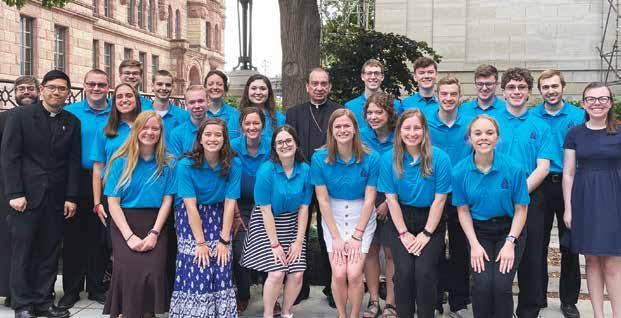
Antes de ascender al cielo, Jesús instruyó a sus discípulos diciendo: “Vayan, y hagan que todos los pueblos sean mis discípulos, bautizándolos en el nombre del Padre y del Hijo y del Espíritu Santo” (Mt. 28:19), y así lo hicieron, con la ayuda y la guía del Espíritu Santo. Los discípulos salieron de Jerusalén y llevaron el mensaje del Evangelio a todos los rincones de la tierra. La Iglesia sigue cumpliendo el mandato de Jesús, y Dios nos llama a cada uno de nosotros a participar en esa misma misión.
La labor de evangelización no es una responsabilidad que le pertenece solamente al clero o a las mujeres y hombres consagrados. Desde el principio, el Evangelio se ha difundido de persona a persona. Cada uno de nosotros tiene la oportunidad de hacer que otros lleguen a conocer a Jesús y la Buena Nueva de nuestra salvación a través de Él. En el bautismo nos hacemos partícipes de la propia vida divina de Dios. Por eso, cada aspecto de nuestras vidas tiene el potencial de ser una vía a través de la cual la gracia de Dios puede llegar a otros. Esto significa que no sólo evangelizamos a través de nuestras palabras, sino que todas nuestras acciones y las decisiones que tomamos también pueden hablar de las verdades del Evangelio.
Una vida que irradia el Evangelio se construye sobre la oración y la virtud. Nos esforzamos por seguir el ejemplo de Jesús, permaneciendo unidos al Padre, en el Espíritu Santo, y procurando actuar como Él, fomentando las cualidades, actitudes y hábitos que Él ejemplificó para sus discípulos. Jesús enseñó a Sus discípulos, y ellos, en cambio, tomaron lo que aprendieron de Él y luego salieron y se lo enseñaron a otros. Los discípulos también traían a sus amigos a Jesús para que pudieran oírlo hablar o, tal vez, ser curados por Él. Era una obra en la que participaban muchos.
Lo mismo sucede hoy: la evangelización se realiza a través de las oraciones, el trabajo y los sacrificios de muchos. Quiero aprovechar este momento para reflexionar sobre el gran regalo que supone el Centro para la Nueva Evangelización (CNE) para nuestra arquidiócesis. Las muchas personas de gran talento que forman el equipo del CNE ayudan a los líderes parroquiales a fomentar una comunión más profunda y el discernimiento de una misión renovada para llevar el Evangelio a todos. También buscan la manera de llegar a los perdidos, a los que se han alejado de Cristo o quizá nunca le han conocido, e invitarlos a un encuentro con el Dios que los ama. El equipo del CNE proporciona recursos espirituales y formación práctica en diversas áreas de evangelización y discipulado: pastoral juvenil, formación en la fe para adultos de todas las edades, matrimonio y vida familiar, y pastoral hispana. De este modo, ayudan a personas de toda nuestra arquidiócesis y más allá de sus fronteras a aprender a vivir una vida que irradia el Evangelio. Muchas de nuestras parroquias se han beneficiado enormemente de los retiros, talleres, conferencias y de la asistencia personalizada que ofrecen los miembros del equipo del CNE. A través de la orientación y los recursos del CNE, los ministerios parroquiales se vuelven más eficaces en la formación de discípulos de Jesucristo. Esto es posible gracias a su generoso apoyo a la Campaña Anual de los Ministerios Católicos (CMA), por lo que estoy profundamente agradecido.
Ninguno de nosotros puede alcanzar el cielo a solas; nos necesitamos mutuamente. Por eso Cristo nos da la Iglesia. Juntos podemos lograr que más personas conozcan, amen y sigan a Jesucristo, pero esa labor comienza con nuestro propio discipulado. Primero debemos estar con el Señor mediante la oración y una vida de virtud, y luego salir y contarle a los demás lo que hemos visto y oído (cf. Lc. 7:22).

What do we know about Judas? Was he forgiven for betraying Jesus? Do we know if he went to heaven or hell?

Judas Iscariot is shown in the Scriptures as the betrayer of Jesus. Even though he walked with Jesus, listened to Him preach, and saw Him heal the sick, his faith in the Lord did not last. He was the apostle who carried the purse and made purchases on behalf of Jesus and the apostles (Jn. 13:29). His concern with money became his motive for betraying Jesus.
The Gospel writers assess Judas negatively, asserting that an evil spirit entered him. John says that Jesus questioned the apostles: “Did I not choose you twelve? Yet is not one of you [Judas] a devil?” (Jn. 6:70). Luke explains that before the Last Supper, Satan entered into Judas (Lk. 22:3). John says that Jesus pointed him out, knowing that he would betray Him. Jesus identified His betrayer: “It is the one to whom I hand the morsel, after I have dipped it.” After Judas took the morsel, the devil possessed him (Jn. 13:26-27).
According to the Scriptures, Judas conferred with the chief priests and elders about betraying Jesus. From that time on, he “looked for an opportunity to hand him over” (Mt. 26:16). While in the Garden of Gethsemane, Judas led a crowd— armed with swords and clubs—to Jesus. Judas approached Jesus and kissed him, signifying that He was the one they should arrest (Mt. 26:47-50).
Matthew is the only Gospel writer to indicate the price of Jesus’ life: the 30 pieces of silver that Judas received in exchange for the betrayal (Mt. 26:15). This price fulfilled an Old Testament prophecy: “And they took the thirty pieces of silver, the value of a man with a price on his head…” (Mt. 27:9). According to Matthew, Judas regretted his choice. He returned the bounty, saying, “I have sinned in betraying innocent blood” (Mt. 27:3-4).
Matthew’s Gospel is also the only one to mention Judas’ death by hanging (Mt. 27:5). Another tradition is found in the Acts of the Apostles, where it says he purchased land “with the wages of his iniquity,” and there “falling headlong, he burst open in the middle, and all his insides spilled out.” The place became known as the Field of Blood (Acts 1:1719).
The Church does not teach that any particular person is in hell—even Judas—despite its belief in hell’s existence and the certainty that there are people in heaven (the saints). Most think it is likely Judas is not in heaven because of Jesus’ words referring to him: “It would be better for him if he had not been born” (Mt. 26:24; Mk. 14:21; Lk. 22:22). This would seem to indicate damnation, but there is no certainty.
The 20th Century theologian Hans Urs von Balthasar asked, “Dare we hope that all men be saved?” Without proposing that all are saved, he asked whether desiring the salvation of others might demand such hope. The Christian tradition offers many examples of conversion, and we trust salvation— even for those who lived manifestly sinful lives.
Peter denied Jesus and was forgiven because he sought forgiveness. He is the “rock” on which Jesus built the Church and is numbered among our great saints. Judas, however, turned in on himself, and while he regretted his choice, he may not have asked for forgiveness. Still, we hold out the possibility of his conversion (as we do for every person) at the moment of death, no matter the gravity of the sins they have committed.

The Body of Christ under the appearance of bread that is reserved after Mass is referred to as the “Blessed Sacrament.” It is used for distribution to the dying (Viaticum), the sick, and those who legitimately cannot be present for the celebration of the Eucharist. Secondly, the Body of Christ in the form of bread is to be adored when it is exposed, as in the Rite of Eucharistic Exposition and Benediction, when it is carried in eucharistic processions, or when it is placed in the tabernacle, before which people pray privately.
Majesty. Wonder. Love. We’ve all glimpsed these feelings, but can only catch shadows of these feelings’ profundity without Jesus. These concepts’ perfect form lies in Jesus alone and can be found in the Most Blessed Sacrament.

The magnificence of the True Presence is difficult to fathom. It’s a profound mystery and one that I, and many Catholics and non-Catholics, have struggled to fully understand. Born a cradle Catholic, I knew when to rise and sit in Mass. I knew the proper responses, just about every hymn in the worship hymnal and could recite the Nicene Creed by heart. I knew that when the host was elevated, I knelt before it. For years, I received the Body and Precious Blood with little-tono internal reverence. I would outwardly bow and monotonously respond “Amen” when prompted, but I lacked a true encounter with Jesus in those regular Sunday experiences. I knew Jesus loved me, and I loved Him fervently through prayer, but I only knew Him from a distance.
This all changed at my very first overnight camp: Catholic Youth Summer Camp. Brimming and overflowing with the Spirit, the Lord’s presence was ablaze
within thousands of youth’s hearts. Our week’s theme happened to be “Death into Life,” and it bore a heavy emphasis on the Eucharist. My little middle school heart loved the Lord, but I had never experienced such intensity in Adoration before.
Yet that night I felt a yearning in the depths of my heart as I listened to the most engaging Eucharistic talks I’d ever heard. The missionaries’ passion was intensely desirable, and they said I could find that joy in the Eucharist. So, trusting in God, I opened my heart to the possibility of the True Presence’s reality, asking the Lord to shower me in grace to understand even the slightest sliver of its mystery.
As I was praying, I gazed at the crucifix, and received an image of Jesus’ Precious Blood dripping from the cross and being collected in a chalice. Overwhelmed, I flung open the doors of my heart to let the Lord work in me as He chose. Entering Adoration, I was stunned by the number of people overcome with happiness as each came face-to-face with the Monstrance. Teenagers and young adults alike were laughing with the purest joy, crying, reaching their arms toward the Eucharist. As the Monstrance was carried







towards me, my doubts were shattered. My soul filled with the most undeniable, immeasurable longing. I hungered for the Lord upon whom I found myself gazing. In the split second that my gaze met Christ’s for the first time in true understanding, I was overwhelmed with the most intense amount of love ever experienced. In that moment, Jesus became real and tangible to me. He was no longer a biblical storybook character living on the page and in my theology tests. I was shaken by the sudden understanding that the Eucharist is not just a symbol—It is Majesty Himself.
Years after this breakthrough, I still struggle to understand the fullness of the Eucharistic mystery. But God gave me this experience of wonder so that through this physical reality, I may love Him more deeply and develop a personal relationship with Him like never before. I

could have remained skeptical, criticizing the scientific impossibilities contained within the mystery. Instead of asking how could He, or why did He, I’ve learned to offer up my “Yes” like our mother Mary. I don’t fully understand, but I believe. All it takes is a yes.
The Blessed Sacrament is the source and summit of Christian life. No other gift can bring us closer to our Lord than through physically coming face-to-face with Him and receiving Him tangibly into our hearts in the form of the Eucharist. He desires intimacy with His beloved creation. He yearns for a relationship with you. Only through opening the doors to our hearts can God move within us so that we may encounter Jesus in the Eucharist and experience His radical love. So, I ask you to open your heart to our Lord in the Most Blessed Sacrament. He will change your life if you let Him.
Sharing the Good News of our faith may seem an easy concept, but it doesn’t always come to fruition. That’s why the Catholic Ministries Appeal (CMA) reserves funds to aid evangelization. “Embracing evangelization in our archdiocese and beyond, in our parishes and through ministries like those supported by the Catholic Ministries Appeal, is so important because it is the reason the Church exists (Evangelii Nuntiandi, 14),” said Matt Reinkemeyer, Director of Development Operations with the CMA. “The Church, that is the people of God, are here to proclaim Jesus Christ and His salvation.”
Reinkemeyer shared that the CMA has several areas of ministry and countless programs within those ministries, many of them focused on evangelism. He highlighted eight and explained how they spread God’s goodness to others.
CAMPUS MINISTRY: Chaplains and lay campus ministers ensure the Good News is shared with college students at the largest public universities in the archdiocese.

CATHOLIC CHARITIES & CATHOLIC SOCIAL SERVICES: These ministries witness God’s love and His Church’s goodness by living out many of the works of mercy, from feeding the hungry and welcoming the stranger to instructing the ignorant and comforting the afflicted.
HOSPITAL MINISTRY: By bringing prayer, a listening ear and the Sacraments, clergy, lay chaplains and volunteers proclaim the Gospel in word, sacrament and presence to those in hospitals.
NEW EVANGELIZATION: The Center for the New Evangelization team equips parish leaders to carry out evangelization and catechesis in their parishes, as well as directly evangelizes through events for youth, young adults,
engaged couples and more.
PRISON MINISTRY: Prison ministry staff and volunteers proclaim the Gospel to Catholic and non-Catholic inmates alike. Their evangelism and witness lead many to the Sacraments of Baptism, Reconciliation and Eucharist.
RETIRED PRIESTS & SENIOR CLERGY: By caring for the clergy who have given over their lives to proclaiming the Gospel and celebrating the Sacraments, these clergy can continue their service well into retirement and be prayer warriors for the conversion of hearts and souls.
SEMINARY AND VOCATIONS: Seminary formation equips future shepherds, preachers, evangelizers and disciple makers for a lifetime of evangelism.
ST. RITA SCHOOL FOR THE DEAF: As it meets the educational and social needs of children who are deaf or have other communication challenges, St. Rita’s also proclaims the Gospel to them.
“The work of sharing the Good News with inmates in prisons within our archdiocese is clearly a part of our duty to evangelization and to Jesus’ call to visit the imprisoned,” said Reinkemeyer. “Yet, this would be a difficult undertaking for any one parish. Likewise for the other ministries supported [by the CMA]. Each contributes to the work of evangelization by responding to the Gospel—especially the works of mercy—and by proclaiming the Gospel to those who may not otherwise hear it in their particular circumstances.”
With donor support, the CMA will continue reaching people in the archdiocese through these ministries and create new ways to share God’s word with all. To learn more and support these ministries, visit CatholicAOC.org/CMA.
“Let us do good to all.”
-Galatians 6:10
More than anyone in the world, the Catholic Church teaches, feeds, and heals. In our local communities, this happens through the Catholic Ministries Appeal (CMA).

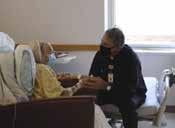
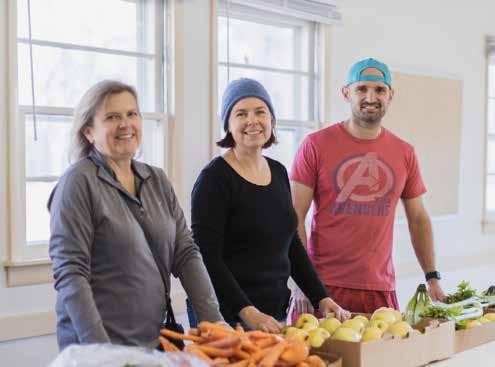
Your gift to the CMA supports:
Catholic Charities and Catholic Social Services

St. Rita School for the Deaf

New Evangelization
Retired Archdiocesan Priests & Senior Clergy

Campus, Hospital, and Prison Ministries

Seminary and Vocations


To make your gift online visit CatholicAOC.org/CMA or text “DONATE” to 513-586-1978 or use your phone’s camera to scan the QR code:


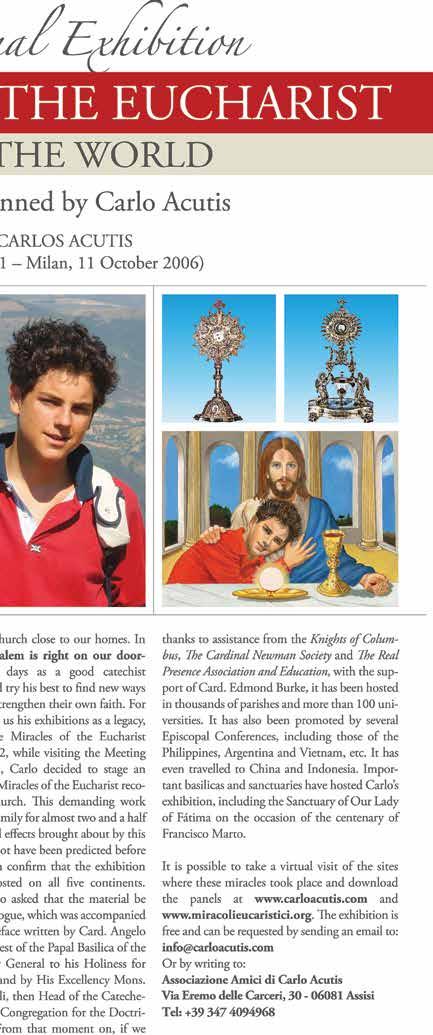 BY BRICE BERGER, SEMINARIAN
BY BRICE BERGER, SEMINARIAN
At every Mass we witness a miracle right before our eyes, but it is a miracle we can apprehend only through the eyes of faith. The bread and wine brought to the altar are changed into the Body, Blood, Soul and Divinity of Jesus Christ. In addition to this astounding miracle, there have been extraordinary moments in history when the Lord manifested His presence in the Eucharist in visible and sensory ways. These events happened across the globe and are called Eucharistic Miracles. Blessed Carlo Acutis documented these and created a traveling exhibition currently available in the Archdiocese of Cincinnati.
The exhibition’s creation began during my internship year at Guardian Angels Parish. I was asked to give a short presentation on a saint’s life to the high school youth group, and while all saints provide great examples of holy lives, I wanted to share the life of a modern-day saint to show that sanctity is achievable today for all men and women, young and old. We are all called to become saints—this is a lifelong journey that must take place every day of our lives.
Blessed Carlo’s continued striving for holiness in the modern world drew me to research and present on his life. While he is not yet a canonized saint, the Church declared him a Blessed because of his exemplary life of holiness during his short 15 years on earth. His constant love of God and lived holiness are summed up in a statement he made as he neared his death from Leukemia: “I am happy to die because I lived my life without wasting even a minute of it on anything unpleasing to God.”
Two of Blessed Carlo’s great joys were computers and technology, and he used these to promote his greatest joy and love: Jesus Christ. He had a profound devotion and love of our Lord Jesus Christ truly present in the Eucharist, and he wanted to visit every Eucharistic Miracle location
around the world. While he was not able to fulfill this dream, he was able to document over 130 Eucharistic Miracles worldwide on his website. His love for our Eucharistic Lord was so great that he wanted to share it with everyone he could: His website has been translated into 18 languages and generated a traveling exhibit reproduced around the world.

What started as simply researching



Blessed Carlo Acutis’ life for a fiveminute presentation quickly grew into a larger endeavor. Desiring to continue his work, I wanted to host the Eucharistic Miracles Exhibition at Guardian Angels Church. While I located a traveling exhibition that can be rented, I had a greater desire to make it available to everyone in the Archdiocese of Cincinnati, especially during the current National Eucharistic Revival. In this time when the Lord’s True Presence in the Eucharist is doubted or rejected, I saw this exhibition as a way to help foster greater devotion and affirm belief in Jesus’ True Presence in the Eucharist.
Through the great generosity and support of two businesses owned by Guardian Angels parishioners, we created Blessed Carlo’s traveling Eucharistic Miracles Exhibition of 190 display panels. It is now available for hosting at no cost to every parish and group in the Archdiocese of Cincinnati. For more information, contact thetruepresence@gmail.com.
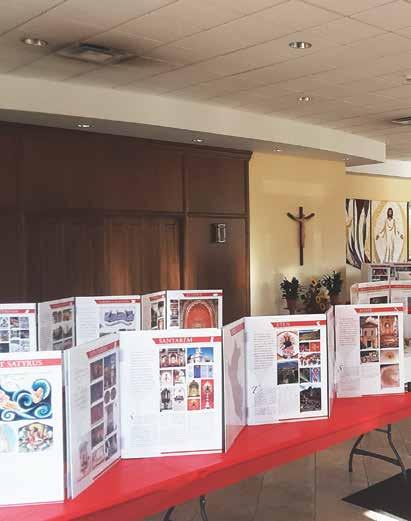
“
Two of Blessed Carlo’s great joys were computers and technology, and he used these to promote his greatest joy and love: Jesus Christ.
As someone who works in the Center for the New Evangelization, it warms my heart to see this issue devoted to evangelization. It’s also edifying to flip through these pages and read so many stories of how people from across our archdiocese live and proclaim the Gospel.
Each story, in its own way, shows us how to evangelize. By arranging a beautiful kaleidoscope of personal presence and initiative, this magazine has the “how” well-covered. So, in this space let’s examine the “what” and the “why.”
What is evangelization? Why do we evangelize?

The Catechism of the Catholic Church (CCC) provides a fitting definition: “Evangelization–The proclamation of Christ and his Gospel (Greek: evangelion) by word and the testimony of life, in fulfillment of Christ’s command.”
Let’s break this down. First, evangelization is “the proclamation”— it’s about saying something. Even when we live well, we are saying something. Furthermore, this proclamation is “of Christ,” which means it is from Jesus and about Jesus. We need to tell people about the “Christ,” the Anointed One, who lived and died in order to save us.
This is a two-fold proclamation that is of “his Gospel”: Not only do we tell people about Jesus, we preach what Jesus preached, namely, “The Kingdom of heaven is at hand” (Mt. 4:17). And to be faithful evangelists, we need to proclaim through a two-fold mode of transmission: “by word and the testimony of life.”
Finally, evangelization is “in fulfillment of Christ’s command.” We evangelize because Jesus commands it of us, especially in the Great Commission: “Go, therefore, and make disciples of all nations … teaching them to observe all that I have commanded you; and lo, I am with you always, to the close of the age” (Mt. 28:19-20).
Jesus’ command should be reason enough to evangelize, but most of us need an extra push, so here are a few more reasons:
In fidelity to Church teaching. The Church teaches that evangelization is the priority of every Christian. Pope St. John Paul II said it well: “No believer in Christ, no institution of the Church can avoid this supreme duty: to proclaim Christ to all peoples” (Redemptoris Missio, 3). And, as Pope Paul VI said: “The Church exists to evangelize” (Evangelii Nuntiandi, 14).
In response to the gifts we received. In Baptism, sin is vanquished, we join God’s family and we are anointed and initiated into Jesus’ prophetic ministry, which includes proclaiming the Gospel. To equip us to build up the Church and her members, we receive charisms, which are graces, and the theological virtues of faith, hope and love.In essence, God lavishly prepared us to evangelize; thus, it’s a complete reversal to not do so. It’s like receiving 10 years of medical training then bagging groceries for a living. Such a person is not living up to the thorough preparation received!
For our own good. Evangelization orients us toward others, but it’s also for our own good, for we step into our authentic identity, becoming the evangelizers God made us to be. It brings more faith, hope, love and joy into our lives because these gifts increase as they are given away. And when we evangelize, we can be sure we are following God’s will for our lives.
For the salvation of all. Ultimately, evangelization is a salvation issue. It’s how we save others (cf. Rom. 1:16), it’s how we save ourselves (cf. CCC, 1816), and it’s one of the best ways to ensure that when we finally meet Jesus, He will acknowledge us before His Father in heaven (cf. Mt. 10:32).
NICHOLAS HARDESTY is the associate director of Adult Evangelization and RCIA for the Center for the New Evangelization. | nhardesty@catholicaoc.org



In seven beautifully filmed episodes, Chris Stefanick and experts from multiple fields of science, medicine, psychology, philosophy, art, and religion examine our place in the larger story of life. Watch

In sports and similar matchups, there is typically a winner and loser by event’s end. But in the game of life, with God as the center, everyone wins. This is evident with St. Xavier High School’s team chaplain program. The 11 team chaplains are St. Xavier teachers and faithfully lead 15 sports teams and the school’s band.
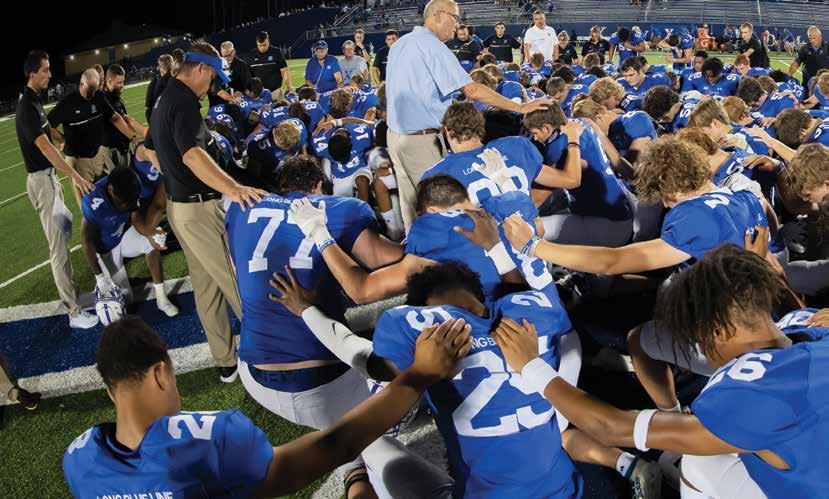
“It was the athletes themselves who [first] showed interest,” said Paul Rieselman, a teacher since 1989, the Director of Contemplatives in Action program and the team chaplain since 2007. “There was no ‘top down’ requirement. Our kids also want to know that this experience has drawn forth from them the personal qualities of high character and camaraderie that will serve them well after the season has ended.”
The idea of having team chaplains started with former St. Xavier head swim coach, Jim Brower. “Year in and year out, Jim and his coaches formed a brotherhood with the boys around the dedication and disciplined hard work that competitive swimming requires,” said Rieselman. “It became clear to me that these boys were not just swimming for trophies; they were swimming for each other.”
“And as a man for others, they choose to lay their gifts at the service of a [greater cause], the team, and to lay those gifts at the service of persons other than themselves, their teammates,” continued Rieselman.
Head football coach, Steve Specht, worked with Father Bill Murphy, S.J., to kick off their own chapel program in 2006, and Specht later asked Rieselman to be the team’s chaplain. Rieselman said, “I knew then that this idea was a tremendous opportunity to meet the boys in an endeavor that they loved, and that through scripture, a few brief words of reflection
and a bit of prayer, they could see that their hard work and personal sacrifice held much more promise for them than scores at the end of the week or trophies at the end of the year. Here, each boy had a chance to get on that road of becoming the man he longed to become…together.”
“And as a man for others, they choose to lay their gifts at the service of a [greater cause], the team...”
As team chaplains, the adults become in-tune with the students’ experiences—in school, in their activities and in their faith life. The chaplain tries to attend practices and most games while staying in constant contact with coaches on how best to meet the team’s needs.


“The chaplain, usually in cohort with the coaches, then chooses a theme that we build upon for that week,” said Rieselman. “We connect the theme every week to a scriptural piece that speaks to the same theme. We always close with prayer.”
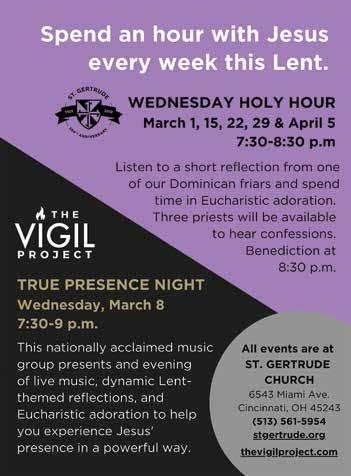
Rieselman also noted that through the team chaplain program, the students are empowered with tools needed to share God’s goodness with others. “The core of our work with our athletes actually flows from what is at the heart of the gospel, Matthew
5:16, ‘Let your light so shine before men, that they may see your good works, and give glory to our Father in heaven,’” said Rieselman. “This is at the heart of true evangelism. God becomes more known to the world because of the way I choose to live my life.”
“God is ingenious,” he continued. “We are enticed to follow what we love. And there, we are taught to become even more loving. Everybody wins.”

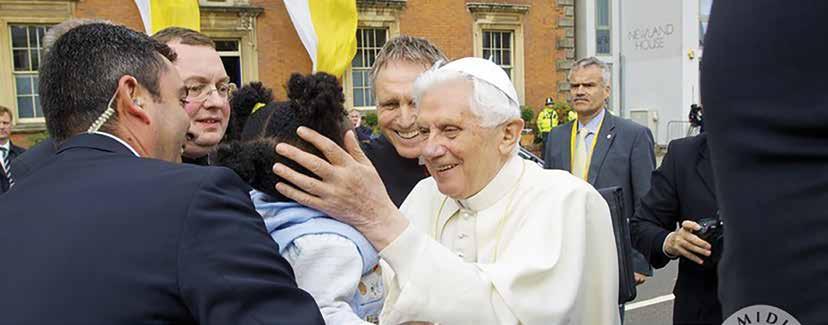
In Evelyn Waugh’s novel, A Handful of Dust, the young son of the main character (Tony Last) is tragically killed in a horseriding accident. Immediately after the accident, the parish vicar comes to Tony’s house to console him, but after the pastor leaves, Tony explains to a friend that he only wanted to discuss funeral arrangements. When the vicar “tried to be comforting,” Tony complains, “it was very painful. After all, the last thing one wants to talk about at a time like this is religion.” The scene calls to mind the late Pope Benedict XVI’s admonition for us Catholics to reinvigorate our faith through what Pope St. John Paul II called the “new evangelization.”
When Pope Benedict XVI died on December 31, 2022, he left a rich historical legacy of service to the Church. His reputation as a world-renowned theologian was already wellestablished before both his 1977 elevation to Archbishop of Munich in his native Germany and his eventual election as the 264th successor to St. Peter in 2005. As a young theologian, Father Joseph Ratzinger was highly influential at the Second Vatican Council as peritus (an official theological advisor) to Josef Cardinal Frings of Cologne, one of the most prominent Council fathers. In that capacity, his greatest contribution was to the “Dogmatic Constitution on Divine Revelation” (Dei Verbum), which he, as a 35-yearold university professor, completely rewrote after reading the poorly crafted first draft. For 24 years before being elevated to Pope (from 1981 to 2005), Cardinal Ratzinger was Prefect of the Congregation for the Doctrine of the Faith, the chief Vatican office overseeing the development of Church doctrine.
Also a prolific author with over 50 books, Father Ratzinger’s
Introduction to Christianity (1968) is one of the most widely read theological books in history. During his eight years as Pope, Benedict wrote three encyclicals: Deus Caritas Est (2005), Spe Salvi (2007), and Caritas in Veritate (2009). And his magnificent three-volume book series, Jesus of Nazareth, may be his most beloved and admired literary legacy. But one of the lesser-known documents of his papacy—and the Vatican institution created by that document—may have a larger impact on the worldwide Church than his encyclicals and other better-known writings. On September 21, 2010, the Feast of St. Matthew the Evangelist, Pope Benedict issued the Apostolic Letter, Ubicumque et Semper (US), to establish the Pontifical Council for Promoting the New Evangelization.
“It is the duty of the Church to proclaim always and everywhere the Gospel of Jesus Christ,” the letter begins. Over the course of the Church’s history, the form of spreading the good news has had to adapt to regional customs, technological advances and political and social developments. “In our own time,” Pope Benedict explains, proclaiming the gospel “has been particularly challenged by an abandonment of faith.” Echoing his other writings and speeches that described the rise of secularization, Benedict describes “a troubling loss of the sense of the sacred,” which has called into question the meaning and purpose [of] some of the most fundamental and common human experiences, such as “birth, death, [and] life in a family.”
Benedict explains that it is in this context that Pope John Paul II makes the “urgent task” of the “new evangelization” a “central point” of his papacy. While John Paul’s call is consistent with Jesus’ charge in the Gospel of Matthew to
“go and make disciples of all nations,” the new evangelization focuses especially on the task of re-evangelizing professed Catholics. John Paul emphasizes evangelizing “particularly in regions Christianized long ago,” says Benedict, where professed Christians now live “as if God did not exist.” He explains that Christians’ “indifference to religion and the practice of religion devoid of true meaning” are as troubling as declared atheism. Professed Christians maintain “some of the externals of … tradition and rituals,” Benedict worries, but separate their faith “from those moments of human existence which have the most significance.” Thus, an urgent agenda for the new evangelization is “a mending of the Christian fabric of society.” Professed Christians can hardly be effective evangelists if they live as though the Gospel makes no difference in their own lives.
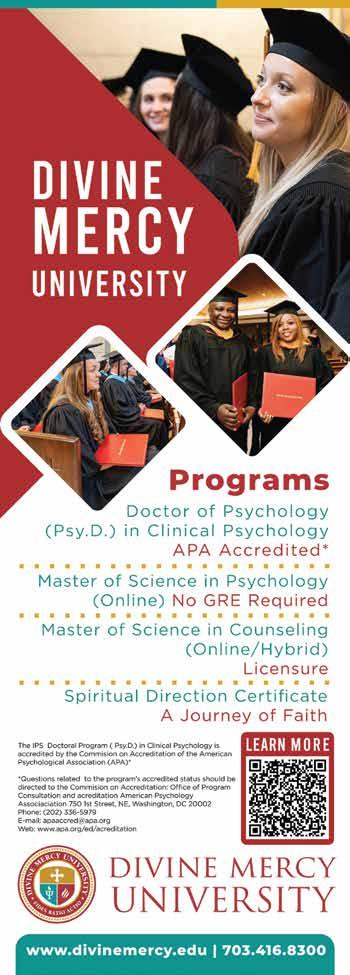

Toward that end, Benedict’s Ubicumque et Semper established the new Pontifical Council and charged it with “identifying and promoting suitable ways and means to accomplish” the new evangelization (US, 1). This included specific instructions, among other things, “to examine … the theological and pastoral meaning of the new evangelization”; to “encourage the use of modern forms of communication”; and “to promote the use of the Catechism of the Catholic Church as an essential and complete formulation of the content of the faith for the people of our time” (US, 3).
Most importantly, though, Pope Benedict tells us directly that to be a Catholic Christian is not to subscribe to a philosophy, but rather to have a personal encounter with the living Christ. Quoting from his encyclical, Deus Caritas Est, the Pope explains, “Being Christian is not the result of an ethical choice or a lofty idea, but the encounter with an event, a person, which gives life a new horizon and a decisive direction” (Deus Caritas Est, 1). As Vatican Council peritus, professor, author and Pope, the late Father Joseph Ratzinger left the Church with a detailed map by which to navigate toward that horizon.
While John Paul’s call is consistent with Jesus’ charge in the Gospel of Matthew to “go and make disciples of all nations,” the new evangelization focuses especially on the task of re-evangelizing professed Catholics.
When guests visit the Church of the Resurrection in Bond Hill for Mass, a funeral or a wedding, they often ask,

The 18-25 member choir brings classical music, traditional hymns, anthems and Gospel tunes to the sanctuary each week, directed by David Fowler and accompanied by a regular drummer and occasional bass guitarist.
The dynamic choir strives to move the congregation to deeper prayer, explained Rita Winters, one of the choir’s longest tenured and most faithful members. “That’s what’s important to me, that we move people and they want to come back.”
Winters grew up in a musical home–her father had albums of every music genre, she took violin lessons until high school and the family often attended the opera, symphony and ballet. However, singing was the habit that stuck. “I’m that child who danced around the living room singing at the top of my lungs,” she laughed.
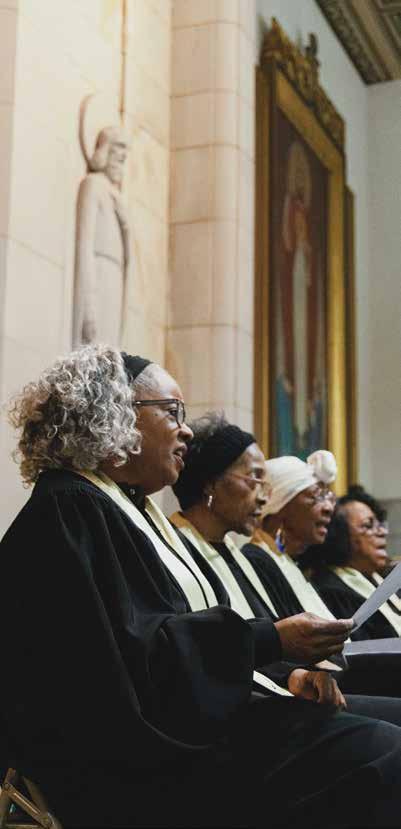
“Is the music like this every week? I have to come back here.”Rita Winters with the Resurrection Choir.
She began singing at St. Agnes School as a child, left and later joined the adult choir at 21, when she married (now Deacon) Royce and settled into the parish. Bringing music to life continued through the parish’s merger into Resurrection Parish 12 years ago.
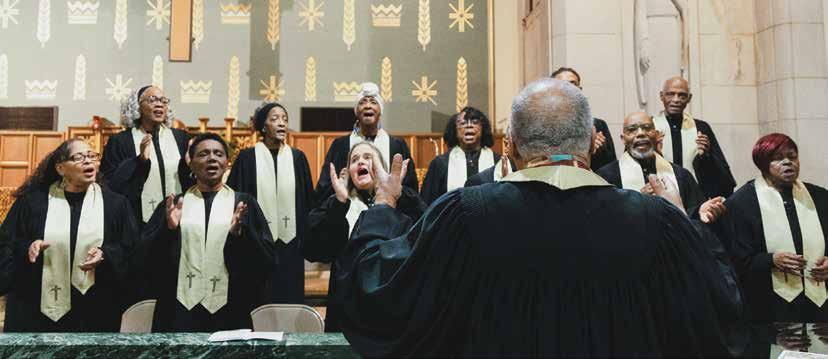
“I’ve been through many music directors, obviously, because I’ve been singing the entire time,” she said. Winters has sung at many churches–including the Cathedral Basilica of St. Peter in Chains–sings for funerals and weddings and enjoys sharing her gifts with the Cincinnati Music Theater and other groups.
“What’s interesting [with] all the music directors, you are always learning,” she said. “They bring different music, gifts and talents to the table, so it’s exciting. They’re pretty diverse so you never know what will happen.”
Winters’ first voice teacher and music director at Resurrection was the late Dr. James Moore, a Black Catholic composer, singer and choir director who directed music at Mount St. Mary’s Seminary & School of Theology in the 1970’s. He eventually shared his music around the globe. It was he who encouraged her to join the Athenaeum Chorale at its inception.
At Resurrection, Winters said, “Total Praise” and “Order My Steps” are two congregation favorites that
bring them to their feet in worship. “I don’t care how many times we sing these songs, the congregation gets quite excited.”
Everyone in the choir can suggest music, and Fowler will train members who want to lead a song, cantor or have a solo. Winters’ goal is to minister through song so that it makes a difference for at least one person who is listening.
“When you are ministering in song, it might not be a song that moves you, but it moves somebody out there… You sing from your heart what the words of that song are trying to convey, and you don’t know what that can mean to someone else. People tell me that all the time.”
The congregation gives back to her by responding, she said. “I might look out and there’s one person connecting to me while I’m singing, and that means a lot to me, that moves me, so it’s a give and take.”
Music tugs at the heart in a way that spoken word doesn’t, Winters shared. “All I do is sing from my heart. I go into the zone, I don’t know what happens. It’s all a gift from God, of song, and all I do is think about the words, what they mean to me, sing it to the best of my ability and try to feel it and open myself up. I don’t worry [if] I miss a note. I just start praying through song in hope.”


Music speaks to our hearts, builds community, provides an opportunity to thank and praise God and can even evangelize and transform lives in unexpected ways.
Such is the case with local folk band Easter Rising. Among its members are Father Adam Puntel (pastor of Our Lord Christ the King, St. Stephen, St. Rose and Holy Cross-Immaculata), Will Egan, Lucas Hennessey and Brandon Schoonover. How the group formed depends on who you ask, said Egan. People in Omaha say it was established in 2001, “When a couple of guys in the seminary started playing together,” but it was 2002 when Egan started playing with his friend, Josh Mincher, at the Pontifical College Josephinum in Columbus.
“He was down in the bar one night and said he wanted to play some Irish music, and he asked if anyone there was a musician,” Egan explained. “I said I was, and he gave me a CD of 10 Irish drinking songs, so I learned them; and we just sat on the bench and played them all one night. So, the band came to be because we wanted to play music together.”
The band’s name, Easter Rising, refers to both Christ’s rising at Easter and the 1916 uprising that led to southern Ireland’s independence from England. Over the years, the band has had about 25 members who joined and stepped away according to their availability. Between six and eight musicians currently participate consistently, while also juggling family and job responsibilities.
They play Irish songs, of course, said Egan, and American tunes, some oldies and classics, and basically whatever inspires them at the moment.
“We’re a group, most of whom are Catholic, who enjoy playing songs together, often in front of other people,” said Egan. “It’s not a ministry in any technical sense, although I suppose Catholics attempting to glorify God through their mutual hobby could be considered ministerial.”

Hennessey, who plays bass and sings lead vocals for about half the band’s songs, has known Egan since 1991. After playing together in rock and Christian punk bands during high school, they went their separate ways. Hennessey attended Franciscan University of Steubenville and played in a local band, until it crossed paths with Easter Rising at a couple shows. That was when he increased his involvement in the band that today is a meaningful musical outlet for him.
Introduced to Easter Rising in 2006, when Egan encouraged him to “get your guitar” and join them for a gig in Omaha, Father Puntel finds great joy in his fellow band members and their music. He said, “It’s something infectious you want to do. You want to share with people. You’ve been given this gift and you don’t just want to let it sit upon a shelf. There’s an energy to it that I don’t think you can fake.”
The band starts every gig with prayer and strives to end with a Marian hymn, he added. “You know, we wear on our sleeves who we are, so I think as we’re playing, we want people to see beauty. We want them to see something transcendent. And I think [we’re] doing that in a way that is accessible. You know, someone may never have gone to a church when they were little, or maybe were never gifted with faith in their families. We might be the only people they meet in their whole journey.”
Opportunities for evangelization are plentiful, noted Father Puntel. Of course, the band is called upon to play gigs around St. Patrick’s Day, but they’ve also played numerous times at Cross the Bridge for Life and performed at other events, including weddings, parish festivals and pregnancy center fundraisers. “We always
try to do things that make a good impact in our world and in our faith,” he said.
Father Puntel noted that the band affected several members in a “unique and beautiful way” when they met their wives through others in the group or at a gig. “Then loved blossomed, and a lot of years later, there are a lot of awesome children in the world and [great Catholic families that] got their start; not entirely because of the band, but it played a role.”

Hennessey believes the band members are best able to evangelize simply by their witness, sense of community and just being themselves. “We are who we are on stage, off stage, and [we] don’t put any airs on about that,” he said. “I think that is, in itself, an indirect display of our faith because we’re not going to hide it, but we’re not going to be preachy and explicit … . But I think that just being out in the world and doing what we do and being who we are interests people in a certain way. And I think there’s something that draws people to come listen to us play.”
“If I’m playing music, it’s a chance to feed [my faith and help it] grow, and connect with others and build community,” Egan said. “I think every moment we’re trying to live our lives in such a way that God is glorified.”

The Church community often implores its members to become evangelists. There are many books and articles written on evangelization, and in general, we Catholics have managed to turn it into a fairly complicated idea that leaves even devout Catholics thinking, “Evangelization sounds great, but I can’t do it.”
Let’s shine a light on what it really means to evangelize. Evangelization means “to share good news.” It’s “good newsization,” and that understanding unlocks a whole realm of possibilities for Catholics. Why? Because sharing good news is already part of your everyday life.
Nobody wants to live a miserable or mediocre life. Everyone wants their life to be as great as it can be. This desire creates a natural human impulse to share what you believe makes your life great. In fact, social media is built on this human impulse— we share family photos, announce a new job or engagement, share an exciting experience and even share photos of a great meal at a restaurant. From a birth announcement to photos of our dinner plates—we love to share good news.
So, the question is not, “Are you an evangelist?” You already share good news. The question is, “What do you evangelize,” or, “What good news do you share?”
At this point you might be thinking, “Well, yeah, it’s easy to share the good news of a birth announcement or make a restaurant recommendation, but sharing the faith isn’t like that. I don’t know the right words to say. I’m not a good enough person. I don’t have a theology degree, so I can’t evangelize.”
If that is your reaction, then I congratulate you: Count yourself among some of the great figures God used in Scripture. Exodus 4:10 tells of Moses’ insistence that the Lord could not use him because he didn’t know the right words to say. St. Paul persecuted Christians. And none of the apostles
had theology degrees.
In truth, there are only three qualities you need to ensure you are sharing God’s goodness with the world (instead of sharing the goodness of that new restaurant’s delicious chicken wings).
The more you look at your life as a great gift from God, the easier it is to share that gift with others. Good things happen and we sometimes forget to thank God. When we thank him for that new job or healthy delivery, it reminds the world of God’s goodness.
Matthew 10:8 commands us, “Without cost you have received; without cost you are to give.” Start by being grateful, end by being generous. Think of the most generous person you know. Don’t you want to be with that person? Don’t they fill you with joy? Don’t they make you want to be a better person yourself?
If you have the first and second qualities, all that is left is to find the courage to remind the world that all goodness and generosity come from God. That’s it. If you are a grateful and generous person, your friends, family, coworkers and neighbors will notice. They’ll wonder how you can be so grateful and generous—all you have to do is tell them that it all comes from God.
Everyone wants to live a great life. We all love to share good news. God is the source of all goodness. When we are grateful for God’s goodness and share it with others, it reminds the whole world of the best news there is: God loves us.
DOMINICK ALBANO
is The Catholic Telegraph’s director of digital engagement, an author and national speaker. He and his wife have been married for 15 years and have four sons. dalbano@catholicaoc.org

Illustrated by Emma Cassani
1847, 1848, 1850
Cholera epidemics devastate Cincinnati, causing many German immigrants to move north and away from “bad air”; Catholics worship at St. James in White Oak.
1854
Archbishop Purcell establishes a new parish for Germans in Mt. Pleasant, first church built.
1858
First school constructed from Europe.
1870
Second church building dedicated.
1881
Church additions begin: side altars, statues, frescoes, stained glass added.
1884
Mount Pleasant renamed “Mt. Healthy.”
1894
Sisters of Divine Providence arrived to teach.
1908
Construction of new school begins.
1921
To help immigrants assimilate, Archbishop Moeller declares that all Catholic schools teach in English.
Assumption
was once one of the Archdiocese’s largest parishes. Begun for German immigrants fleeing cholera in the city, it served 1,200 families by the late 1950s, the height of Catholic population in the northern suburbs.

The ancient belief of the Church in both the East and West, and a feast since about the year 600, the Assumption of Mary refers to the Blessed Virgin “being taken up body and soul into the glory of Heaven” and was declared a dogma in 1950. In the East, it’s referred to as the “Dormition.”
1957
New “church/hall” building constructed; originally meant to be converted to auditorium, it becomes the permanent church.

1964-1966




New school built.
1978
Arson destroys the church interior; Mt. Healthy High School invites the parish to hold Mass in its gym during repairs. Church reopens with contemporary stained glass windows and the altar moved to the “side” of the building.
1994
Last Sisters of Divine Providence leave.
1995
Parish Center built.
Rick Brandell, a member of St. Maximilian Kolbe parish in Liberty Township, was inspired to write a children’s book about faith while praying the Rosary one day. He mulled over that seed of inspiration for six months before deciding it was time to act.
“The idea was that I should write a children’s book helping kids understand the concept of spirit, and that I should use as my template F.J. Sheed’s classic work of introductory theology, Theology for Beginners But, once I got started, it took four years of working on it in my spare time to complete,” said Brandell.
And while four years may sound like a long time, Brandell was meticulous about the book’s craft. With 34 pages and original illustrations, he was prepared to take the time to create what he imagined. But Brandell stuck with it, compelled by the Center for Applied Research in the Apostolate at Georgetown University that documented that children are losing their faith at an ever-decreasing age.
“A random sampling of young people were surveyed who were raised Catholic, but left the Church, and asked why? Of course, there were lots of reasons, but out of the six most frequent answers, half were for reasons related to science and lack of proof for the existence of God,” said Brandell. “... The average age that a child leaves the Catholic faith is just 13 years old, with 23% leaving under the age of 10. So, Mom
and dad may still be taking these kids to church, but mentally, they’ve left, just sort of checked out. So, this must be addressed.”
Titled Look With Your Spirit , the book concept Brandell settled on tells the story of a father and his young daughter, Rose, on a trip to the park. While there, Rose asks her father, “Where is God?” Despite his answer of “God is everywhere,” Rose remains confused because she can’t see God.
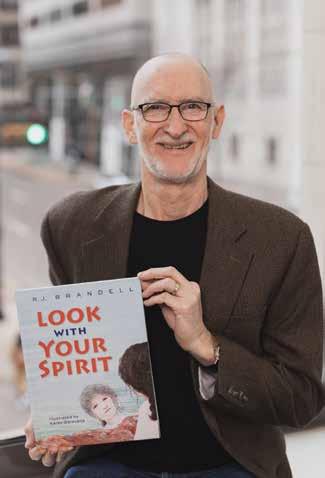
“And the question [in the book is] this: ‘If I can’t see God, hear God, touch God using my senses - that is - my eyes, my ears, etc., does God really exist?’” said Brandell. “Now, there’s a theological answer to that question that children can easily understand, so the book is a tool to help parents teach their kids. But it all begins with understanding the nature of spirit.”
Brandell asserted that children can understand theological concepts, especially if they are presented in an approachable way. “I remember being with a group
of friends on the playground in third or fourth grade when one of them remarked, “If God doesn’t exist, how did all this stuff get here?’” said Brandell. “While not stated with the same precision, my childhood friend quite nicely summed up Thomas Aquinas’ first proof for the existence of God. … Nobody thought our friend’s remark was particularly brilliant. … How does something come from nothing? Of course, children are too young for college level theology, but we don’t have to wait for kids to grow up before teaching the basics.”
Through the use of illustration Look With Your Spirit teaches three important lessons: What a spirit is not; what a spirit is; and what a spirit does. “A spirit knows and loves. Can our thoughts be measured or our love weighed? Doesn’t most everyone believe that these are the two most important and powerful things in the world? The atom may contain great power, but what’s more powerful, the atom or the immaterial mind that learned how to split it?” asked Brandell.
Brandell has been a professional pilot for over 30 years. In 1994, while living in Ypsilanti, MI, he took a job flying night cargo out of CVG. However, the commute from Michigan was less than ideal. In March of 2000, Rick moved his wife Judy and two young daughters, Maria and Hannah, to West Chester in order to be together more as a family. Currently, Rick flies private air charter and is still based in Cincinnati.


Look With Your Spirit can be purchased on Amazon and Barnes & Noble. Locally, it’s available at The Catholic Shop in Madeira; the Holy Spirit Catholic Shop at Our Lady of the Holy Spirit Center in Norwood; and West Chester Toys in West Chester.

The book is a tool to help parents teach their kids. But it all begins with understanding the nature of spirit.BY BONNY VAN
At St. Gabriel Consolidated School in Glendale, students are busy building rockets, electrical circuits, solar cars and bridges. But they’re not just constructing things, they’re playing and learning as they create; it’s part of the school’s Aerospace/STEM program, supported by the Civil Air Patrol. Coordinator Kate Szczap hopes the initiative builds a foundation for future scientists.
“The students love it, they have so much fun,” Kate said.
When Kate’s daughter, Courtney, became a cadet at 12, Kate became a volunteer and saw first-hand the benefits of the Civil Air Patrol. Cadets participated in community service, military-style physical fitness and civil air patrol projects. Now 19, Courtney is a student at Embry-Riddle Aeronautical University in Daytona, FL.
Kate’s husband, Steve, is a pilot, and they have two other daughters, Allison, 17, and Rachel, 13. Having degrees in chemistry and biochemistry but no background in engineering, Kate was excited when she learned about the Civil Air Patrol’s free Aerospace/STEM (Science,
Technology, Engineering and Math) education partnership with schools.
Kate said, “I brought it to my principal [Kerry Shellton] and said I think our school should do this… you should get someone to do that. She turned around and said, ‘How about you?’”
Launching the program at St. Gabriel School in 2019, Kate said it started strong, but COVID-19 curtailed STEM activities. After things opened up, “the school was [playing] catch-up,” making it tough to use class time for extra activities. However, “now that we’ve been through it a couple of times, we’re working better with [it],” she said.

“We circle the dates that Civil Air Patrol is coming to our classroom,” said fifth-grade teacher Stephen Imwalle. “This STEM program encourages students to work collaboratively and to think critically. The hands-on activities are a perfect complement to the concepts we [explore] in our science curriculum.”
Once a month, Kate visits each class for hands-on activities related to aerospace education, character development and physical fitness. And there are plenty of activities underway!
Fifth-graders are building their own rockets, with an April launch date. Sixth-graders are studying electricity with Snap Circuits. Seventh-grade students are using KNEX building materials to study renewable energy—they’ve built solar cars and are moving onto wind turbines. And eighth-grade students are applying physics and geometry to build bridges, in preparation for “bridge breaking” day when students stress test their structures.
“We are so grateful to Mrs. Szczap for bringing these lessons to our school,” said Shelton. “STEM lessons are a great way for students to become confident and interested in math and science, but they also are important because our kids learn that our first ideas aren’t always going to be successful. Being able to analyze an initial attempt at a problem, figure out what isn’t working, and try other solutions are life skills that will benefit [them].”
A Primary Science Night in March for grades Kindergarten through third will focus on famous aviators. Older students will lead younger ones through crafts and experiments to demonstrate the achievements of Amelia Earhart, Charles Lindbergh, the Wright brothers and others.



“The program is a favorite among the second graders,” said Carolyn Moore, a second-grade teacher. “The students are always engaged in the activities.”

“I … know that some kids who say, ‘I don’t like science,’ are still having fun when I’m there,” said Kate. “So as long as they’re not turned off by it, I consider it a positive direction to be moving in. And, I think the more they do these activities, the more confidence they’ll have, knowing they can do these things.”

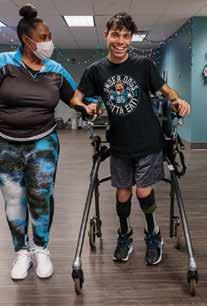
 BY JESSICA RINAUDO
BY JESSICA RINAUDO
The National Men’s Conference is a one-day event filled with virtue, inspirational speakers, fellowship, networking and spiritual growth. Hosted in Cincinnati at Xavier University on March 25, its goal is to bring men together in faith, regardless of where they may be on their faith journey.
“[The conference’s] sole mission is to strengthen men to be the best versions of themselves through Jesus Christ and to fellowship with each other, helping iron sharpen iron,” said Joe Condit, founder and chairman of the National Men’s Conference. “Our goal is to grow men in Christ and change their habits for the better by giving them the fellowship and resources to do it, plain and simple.”
The conference is bringing in some powerhouse speakers to help inspire the men who travel from across the country to attend the event. The headliner is Jonathan Roumie, known for his role as Jesus on the popular show The Chosen about the life of Christ. Roumie publicly professes and speaks about surrendering to God and His Will. This past January, at the National March for Life in Washington D.C., Roumie spoke passionately about how faith can change us.
“Having played the Son of God for the last three seasons on a television show… I’ve spent a lot of time dwelling in the realm of spirit. Through prayer, meditation, and the sacraments of my faith, let me tell you. It changes you from the inside out, and that’s a good thing, but it can be scary. Because, you see, you begin to see the truth manifest itself in all areas of your life, like a veil that’s been lifted… and you can’t unsee what you have seen,” he said.
Archbishop Dennis M. Schnurr will celebrate Mass at the conference, beginning the day by leading the men with an inspirational homily.
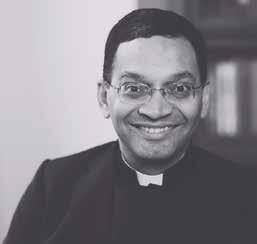
Known for his always-present smile and unparalleled

intellect, Bishop Earl Fernandes of the Diocese of Columbus and former priest of the Archdiocese of Cincinnati will speak on “Being the Best Man You Can Be.”
True to the conference’s mission of creating “focus on all men of Christ’s Church, equipping them with the means and resources necessary to carry out His work,” the conference has recruited speakers outside the box, including His Royal Highness, Archduke Christian Habsburg-Lorraine of Austria. The Archduke is the direct descendant of Blessed Karl of Austria and will speak on who we are called to be as Catholic leaders.
Father Robert Spitzer, known for his work on EWTN and his personal journey as a blind priest, will share his own stories of inspiration, overcoming adversity, and finding God in hardships. Father Spitzer will highlight how we are all part of the Body of Christ.
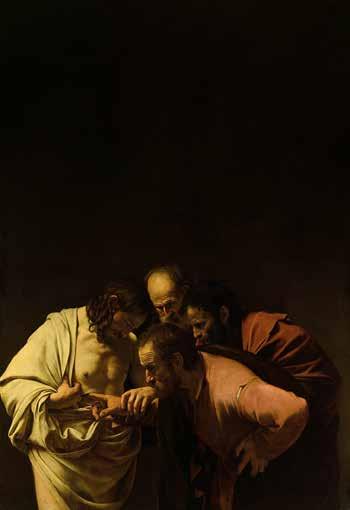
Sports fans everywhere, especially in Cincinnati, will have the rare treat to hear a panel of NFL team members and staff of the Cincinnati Bengals speak on faith. Guests include assistant coach Mark Duffner and center Ted Karras, as well as the team’s chaplain Father Tom Wray.
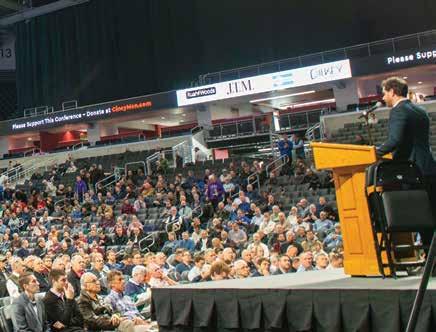
In addition to the onsite inspiration at the men’s conference, the planning team has built an online space for ongoing connection and inspiration.


“The social connect platform my team and I built gives all men who attend in person or virtually the ability to connect with each other, [and foster] fellowship, communication, networking and friendship. We will be using this platform throughout the year to launch and maintain men’s groups,”



My husband and I were exchanging ideas—sweets, alcohol, eating between meals. What to give up for Lent? On Easter I want to experience the deep, abiding joy offered through Christ’s victory over death, which I know calls for a sacrifice that asks a lot of me. As I opened my mouth to say exactly this, I realized my answer was quite literally in front of me. I need to give more of myself to my husband.
Marriage is my life’s work, my greatest call. A priest told us, “Your vocation is not to a general idea of marriage; it’s to Andrew. And God will call to you from within that vocation.” Marriage is my path to Heaven; so, I’m focusing my sacrifices and efforts on seeing that the Lord Himself designed us to be conduits of love and mercy to each other, which is made possible by imitating Christ.
With this in mind, here are some sacrifices, mindset shifts and efforts for married couples to offer during Lent to make a gift of self to Jesus through your sacramental marriage.

Encounter Jesus together. He is not only the source and summit of the Catholic faith, but also of your relationship. In times of peace or trouble, my greatest consolation has come when Andrew and I were together in front of the Eucharist.
Meet during lunch at a nearby parish. If you can’t visit as a couple, bring your spouse’s intentions with you before the Lord; as Andrew’s wife, I’m his designated intercessor.
Sin always gets in the way of trying to be and do good. Make a plan to go to Confession monthly as a couple and/or family, and treat it as an unbreakable appointment. The graces that flow from the Sacrament of Reconciliation are abundant, powerful and ours for the asking! A clean heart makes for a greater ability to imitate Christ to each other.
Are her keys in a spot where she doesn’t keep them? Put them away. Do a load of laundry or clean the bathroom counter.
Help make life at home peaceful for each other, so it’s a soft place to land rather than a point of frustration.
Put the answer at the top of your To Do list and make it happen. I admit this is a tough one because we tend to guard our time; but willingly handing over our energy and time for the other helps us realize that “we” are bigger than “me.” Simultaneously, we each feel seen, supported and loved by the other.
It doesn’t have to be complicated, just honest. If you don’t pray together already, begin with one Glory Be prayed in unison. If you already pray together, add another way to be with God, like the Rosary or Chaplet of Divine Mercy. If you want to increase your spiritual intimacy, pray over each other out loud—speak to Jesus about your spouse and let him/her listen.
FAST.
Abstain from something—cream and sugar in coffee, snacks, butter on toast—and make it a prayer. Offer small sacrifices specifically for your spouse’s salvation and well-being.
But what if only one of you is willing to do any of the above?
Then go to Mass and Confession on your own. Pray faithfully, never ceasing to bring your spouse and relationship to God. Jesus is the Author of your particular marriage and wants to be invited into it to strengthen you both, which means making room for Him to work.
When we repeatedly present ourselves to God in Mass, Confession and prayer, we receive divine strength to love and sacrifice in our marriages. Then, on Easter, after having spent weeks putting to death our own desires for our spouse’s sake, we will experience deep joy from doing so with the Lord.
KATIE SCIBA is a national speaker and Catholic Press Awardwinning columnist. Katie has been married for 14 years and is blessed with six children.

Ascension
Information subject to change. Visit thecatholictelegraph.com for the latest updates.
2025 Woodman Dr., Kettering (in the PAC) (937) 253-5171
Fish Fry: Feb 24; 6-8:30 p.m. Carryout in the Cafeteria: 5-6 p.m.
Carroll High School
4524 Linden Ave., Dayton (937) 253-8188
Fish Fry: Mar. 10; 6 p.m.–Midnight; Drive-Thru Carryout 4:30–5:30 p.m
Catholic Kolping Society
10235 Mill Rd., Cincinnati
Fish Fry: Feb. 24, Mar. 3, Mar. 10, Mar. 17, Mar. 24, Mar. 31; 5:30–7:30 p.m.
Chaminade Julienne High School
505 S. Ludlow St., Dayton (937) 461-3740
Fish Fry: Mar. 18; 6 p.m. Games at 7 p.m.
Church of the Resurrection
1619 California Ave., Cincinnati (513) 242-0400
Fish Fry: Feb. 24, Mar. 3, Mar. 10, Mar. 17, Mar. 24, Mar. 31; 4–7 p.m.
Carry-out Only
Church of the Transfiguration
972 S. Miami St., West Milton (937) 698-4520
Fish Fry: Feb. 24 and Mar. 31; 6–9 p.m.
Church of the Visitation of the Blessed Virgin Mary; K of C #3698
407 E. Main St., Eaton
Fish Fry: Mar. 3, Mar. 10, Mar. 17
5–7 p.m. or ‘til the fish runs out.’ Dine in or carryout. (No drive-thru)
Good Shepherd
8815 E. Kemper Rd., Cincinnati (513) 489-8815
Fish Fry: Feb. 24, Mar. 3, Mar. 10, Mar. 17 5 p.m.–7:30 p.m. (Driv-thru 5–7 p.m.)
Guardian Angels
6531 Beechmont Ave., Cincinnati (513) 231-7440
Fish Fry: Feb. 24, Mar. 3, Mar. 10, Mar. 17, Mar. 24, Mar. 31; 5–7 p.m.
Holy Angels
1300 4th Ave, Sidney (Sidney Knights of Columbus Hall)
Fish Fry: Feb. 24, Mar. 3, Mar. 10, Mar. 17, Mar. 24, Mar. 31, April 7; 5–7 p.m.
Holy Family Knights of Columbus
1405 First Ave., Middletown (at St. John Undercroft)
Fish Fry: Feb. 24, Mar. 3, Mar. 10, Mar. 17, Mar. 24, Mar. 31, April 7; 5–8 p.m.
Holy Trinity
272 Bainbridge St., Dayton (Trinity Center) (937) 228-1223
Fish Fry: Feb. 25; 6:30–8:30 p.m. Games: 7–10:30 p.m.
Immaculate Conception K of C
129 N. Vine St., Celina (419) 586-6648
Fish Fry: Feb. 24, Mar. 3, Mar. 10, Mar. 17, Mar. 24, Mar. 31, April 7; 5–7p.m.
Immaculate Heart of Mary
7820 Beechmont Ave., Cincinnati
(513) 388-0031 (Fish Fry in Cafeteria)
Fish Fry: Feb. 24, Mar. 3, Mar. 10, Mar. 17, Mar. 24, Mar. 31; 4:30–7 p.m.
Incarnation
45 Williamsburg Ln., Centerville
(937) 433-1188
Fish Fry: Mar. 10; 7–Midnight Carryout from 5–6:30 p.m.
K of C #1782 Bellefontaine
316 E. Patterson Ave., Bellefontaine
(Makley Hall)
(937) 592-1656
Fish Fry: Feb. 24, Mar. 3, Mar. 10; 5–7 p.m.
K of C #1683 Northside
3144 Blue Rock Rd., Cincinnati
(513) 741-7700
Fish Fry: Feb. 24, Mar. 3, Mar. 10, Mar. 17, Mar. 24, Mar. 31, April 7; 5–7:30 p.m.
K of C #8115 Sacred Heart, Fairfield
400 Nilles Rd., Fairfield, (Fellowship Hall)
(513) 858-4210
Fish Fry: Mar. 10, April 7; 5:30–8 p.m.
K of C #1592 Saint Marys
K of C Hall, Spring & Pine Sts., Saint Marys
(419) 394-5050
Fish Fry: Mar. 31; 4:30–7 p.m.
K of C #624 Springfield

2055 S. Bird Rd., Springfield
(937) 323-9663
Fish Fry: Feb. 24, Mar. 3, Mar. 10, Mar. 17, Mar. 24, Mar. 31; 6 p.m.
K of C #1727 Urbana
518 N. Locust St., Urbana
Fish Fry: Feb. 24, Mar. 3, Mar. 10, Mar. 17, Mar. 24, Mar. 31; 5:30–7:30 p.m.
K of C #1272 Wapakoneta
614 N. Dixie Hwy, Wapakoneta (419)-738-2218
Fish Fry: Feb. 24, Mar. 3, Mar. 24, April 7 4:30–7p.m.
Old St Mary’s
123 E 13th St., Cincinnati (513) 721-2988
Fish Fry: Mar. 3; 5 p.m.
Our Lady of Sorrows
330 Lebanon Street, Monroe (513) 539-8061
Fish Fry: Feb. 24, Mar. 3, Mar. 10, Mar. 17, Mar. 24, Mar. 31; 4:30–7:30 p.m.
Our Lady of the Valley Sts. Peter and Paul Campus
330 W Vine St., Cincinnati (513) 554-1010
Fish Fry: Mar. 3, Mar. 10, Mar. 17, Mar. 24, Mar. 31, April 7; 5–7 p.m.
Sacred Heart
209 W. Lake Ave., New Carlisle (Parish Center) (937) 845-3121
Fish Fry: Feb. 24, Mar. 3, Mar. 10, Mar. 17, Mar. 24, Mar. 31; 5–7 p.m.
St. Aloysius
3350 Chapel Rd., Shandon (513) 738-1014
Fish Fry: Feb. 24, Mar. 3, Mar. 10, Mar. 17, Mar. 24; 4:30–7 p.m.
St. Ann
3064 Pleasant Ave., Hamilton (513) 863-0604
Fish Fry: Mar. 31; 5–9 p.m.
St. Anthony of Padua
830 Bowen St., Dayton (937) 253-9132
Fish Fry: Feb. 25; 6–11 p.m.
St. Antoninus
1500 Linneman Rd., Cincinnati (in undercroft)
(513) 922-5400
Fish Fry: Feb. 24, Mar. 3, Mar. 10, Mar. 17, Mar. 24, Mar. 31, April 7; 5–7 p.m
4380 Buckeye Lane, Suite 200 Beavercreek, OH 45440 937-431-7890
james.ghory.jr@morganstanley.com

www.morganstanleyfa.com/james.ghory.jr
NMLS #1657687

St. Bernard
745 Derby Ave, Cincinnati
(513) 722-6899
Fish Fry: Mar. 10, Mar. 24
5:30–7:30 p.m.
St. Brigid
312 Fairgrounds Rd., Xenia
(937) 372-3193
Fish Fry: Mar. 3; 6–11p.m.
Carryout 4:30–6 p.m.
St. Catharine of Siena
Drive-thru at the school
3324 Wunder Ave., Cincinnati
Feb. 24, Mar. 3, Mar. 10
5–7 p.m.
At Westside Brewery
3044 Harrison Ave., Cincinnati
Mar. 17; Noon–9 p.m.
St. Cecilia
3105 Madison Rd., Cincinnati
(513) 871-5757
Fish Fry: Mar. 17; 4–7:30 p.m.
St. Charles Borromeo
4600 Ackerman Blvd., Dayton
(Fish Fry at the School)
(937) 434-6081
Fish Fry: Friday, Mar. 17; TBA
St. Christopher
435 E. National Rd., Vandalia
(937) 898-3542 ext. 200
Fish Fry: Feb. 24, Mar. 3, Mar.
10, Mar. 17, Mar. 24, Mar. 31
6–7:30 p.m.
St. Columban
894 Oakland Rd., Loveland
(513) 683-0105
Fish Fry: Feb. 24, Mar. 3, Mar.
10, Mar. 17, Mar. 24, Mar. 31
5–7:30 p.m.
St. Columbkille
73 N. Mulberry, Wilmington (Parish Center Basement) (937) 382-2236
Fish Fry: Feb. 24, Mar. 3, Mar.
10, Mar. 17, Mar. 24, Mar. 31
4:30–7 p.m.
St. Elizabeth Ann Seton
5890 Buckwheat Rd., Milford (513) 575-0119


Fish Fry: Feb. 24, Mar. 3, Mar. 10, Mar. 17, Mar. 24, Mar. 31; 5–7:30 p.m.
St. Ignatius of Loyola 5222 North Bend Rd., Cincinnati (513) 661-6565
Fish Fry: Feb. 24, Mar. 3, Mar.
10, Mar. 17, Mar. 24, Mar. 31
5–8 p.m.
St. James of the Valley 411 Springfield Pike, Cincinnati (513) 948-1218
Fish Fry: Mar. 10
5–7 p.m.
St. James the Greater 3565 Hubble Road, Cincinnati (513) 741-5300
Fish Fry: Feb. 24, Mar. 3, Mar. 10, Mar. 17, Mar. 24, Mar. 31
4:30–7:30 p.m.
To order for drive-thru pick up, download the app: mymenuhelper and select St. James Fish Fry for easy pick up in our parking lot!
St. John the Baptist 5361 Dry Ridge Rd., Cincinnati (513) 385-8010
Fish Fry: Feb. 24, Mar. 3, Mar. 10, Mar. 17, Mar. 24, Mar. 31
4:30–7:30 p.m.
St. John the Evangelist 9080 Cincinnati-Dayton Rd., West Chester (513) 777-6433
Fish Fry: Feb. 24, Mar. 3, Mar. 10, Mar. 17, Mar. 24, Mar. 31 4:30–7 p.m.
St. Lawrence 3680 Warsaw Ave., Cincinnati (Heritage Hall ) (513) 921-4230 to order ahead!
Fish Fry: Feb. 22, Feb. 24, Mar. 3, Mar. 10, Mar. 17, Mar. 24, Mar. 31; 4–7 p.m.
St. Louis 250 N. Broadway, Owensville (513) 732-2218
Fish Fry: Feb. 24, Mar. 3, Mar. 10, Mar. 17, Mar. 24, Mar. 31 5–8 p.m.
St. Margaret of York 9483 Columbia Rd., Loveland
Fish Fry: Feb. 24, Mar. 3, Mar. 10, Mar. 17, Mar. 24, Mar. 31
5–7:30 p.m.
St. Mary
3398 State Route 125, Bethel (Parish Center)
(513) 734-4041
Fish Fry: Feb. 24, Mar. 3, Mar.
10, Mar. 17, Mar. 24, Mar. 31
4:30–7:30 p.m.
St. Mary
2853 Erie Ave., Cincinnati
(in St. Mary’s Cafeteria)
(513) 321-1207

Fish Fry: Mar. 31; 5–7:30 p.m.
St. Mary
528 Broadway St., Piqua
(in Piqua Catholic North Campus cafeteria)
(937) 773-1327
Fish Fry: Feb. 24, Mar. 3, Mar.
10, Mar. 17, Mar. 24, Mar. 31
5–7 p.m.
St. Maximilian Kolbe
5729 Hamilton Mason Road, Liberty Twp
(513) 777-4322
Fish Fry: Feb. 24, Mar. 3, Mar.
10, Mar. 17, Mar. 24, Mar. 31
4:30–7 p.m.

St. Michael 11144 Spinner Ave., Cincinnati
(513) 563-6377
Fish Fry: Mar. 24

4:30–7:30 p.m.
St, Michael 210 High St., Mount Orab
(937) 444-3944

Fish Fry: Feb. 24, Mar. 3, Mar.
10, Mar. 17, Mar. 24, Mar. 31
4:30–7:30 p.m.
St. Michael the Archangel
4th & Market Sts., Ripley
(in Parish Hall)
(606) 375-9947
Fish Fry: Feb. 24, Mar. 3, Mar.
10, Mar. 17, Mar. 24, Mar. 31
Lunch: 11 a.m.–1 p.m.

Dinner: 4–7 p.m.
St. Peter
1192 Bethel New Richmond Rd., New Richmond
(513) 553-3267
Fish Fry: Feb. 24, Mar. 3, Mar.
10, Mar. 17, Mar. 24, Mar. 31
5–7:30 p.m.
St. Philip the Apostle
944 E. US 22 & 3, Morrow
(513) 899-3601


Fish Fry: Feb. 24, Mar. 3, Mar.
10, Mar. 17, Mar. 24, Mar. 31
5–7 p.m.

Carryout Available
St. Saviour
4136 Myrtle Ave., Cincinnati
(513) 791-9004
Fish Fry: Feb. 24
5–7:30 p.m.
St. Susanna
500 Reading Rd., Mason
(Meyer Center)
(513) 398-3821
Fish Fry: Feb. 24, Mar. 3, Mar.
10, Mar. 17, Mar. 24, Mar. 31
4:30–7:30 p.m.
St. Thomas More 800 Ohio Pike, Cincinnati (513) 752-2080
Fish Fry: Feb. 24, Mar. 3, Mar. 10, Mar. 17, Mar. 24, Mar. 31
5–7:30 p.m.
St. Veronica 4473 Mt. Carmel-Tobasco Rd., Cincinnati (in Parish Hall) (513) 528-1622
Fish Fry: Feb. 24, Mar. 3, Mar. 10, Mar. 17, Mar. 24, Mar. 31
5–7:30 p.m.
St. Vincent Ferrer 7754 Montgomery Rd., Cincinnati (513) 791-9030
Fish Fry: Mar. 10, Mar. 17, Mar. 24, Mar. 31

5:30–7:30 p.m.
St. William 4108 W. 8th St., Cincinnati (513) 921-0247
Fish Fry: Mar. 3, Mar. 10, Mar. 17, Mar. 24, Mar. 31
4–7:30 p.m. Drive-thru only
Note: This article is part of an ongoing series on Pope St. John Paul II’s “Theology of the Body.”
As described in my previous article, Pope St. John Paul II regarded the emergence of shame in the wake of the original sin committed by our first parents as a “boundary experience” that demarcates original man and historical man. Prior to this experience, man and woman were naked and felt no shame, but after their rebellion and fall from grace, they hid themselves from God and from each other. Last month, we looked at the impact of original shame on man’s relationship with God. Let’s now look at how it has impacted the relationship between the sexes.
Original shame reflects a decisive shift in the relationship between man and woman. Prior to original sin, we have seen that our first parents experienced a “fullness of consciousness of the meaning of the body” reflected in their experience of being naked without shame (TOB 12.3). The purity of vision they enjoyed enabled them to see the inner reality of the person made in God’s image revealed through the body, and it moved them to affirm the dignity of the person in all their interactions. Their desires, including for sexual union, were fully integrated with this purity of vision and intention toward one another. Being in the state of original innocence and filled with God’s grace, their interior and interpersonal lives were fully ordered toward love and respect for the person.
After their fall from grace, our first parents’ situation radically changes. The man begins to experience shame in regard to the woman and vice versa. This “reciprocal shame” “compels them to cover their nakedness, to hide their own bodies, to withdraw from man’s sight what constitutes the visible sign of femininity and from woman’s sight what constitutes the visible sign of masculinity” (TOB 28.1). Pope St. John Paul II attributed this sexual shame to the emergence of concupiscence.
Concupiscence refers to the inclination to sin that all of us experience because we inherit a fallen, wounded human nature. It emerged in our first parents after original sin, which damaged

the harmonious integration they had experienced within themselves and in their relationships with God, each other, and the rest of creation. In particular, after original sin, “the control of the soul’s spiritual faculties over the body is shattered; the union of man and woman becomes subject to tensions, their relations henceforth marked by lust and domination” (CCC, 400).
The disharmony within the human person naturally leads to disharmony between man and woman. Their desires for one another are no longer properly ordered and instinctively guided by truth and love. Rather, when they see one another’s bodies, they now see primarily the exterior features rather than the interior reality of the person. The purity of vision that previously enabled them to always behold the dignity of the person now gives “up its place to the mere sensation of ‘sexuality’” (TOB 29.3). With concupiscence, man and woman are now prone to see each other as objects of use. Indeed, we struggle to see the inner reality and dignity of the person revealed by the body and tend to settle merely on the exterior features, judging and evaluating according to our selfish purposes.
This situation gives rise to shame between man and woman in two ways. First, we experience shame because we are aware that we are not in control of our desires toward each other and the bodily manifestations of these. We experience sexual feelings and respond to sexual signals even when we do not will it. Shame moves us to hide this inner state of disorder and the bodily manifestations of it from one another. Second, shame emerges to protect us from the now disordered gaze of others. Sensing that others may see us in a disordered way, shame takes on a protective function, moving us to conceal the sexual features of our bodies and exercise modesty. We will delve more into this positive, protective aspect of shame next time.
DR. ANDREW SODERGREN, MTS, PSY.D. is a Catholic psychologist and director of psychological services for Ruah Woods. He speaks on the integration of psychology and the Catholic faith. He and his wife, Ellie, have five children.



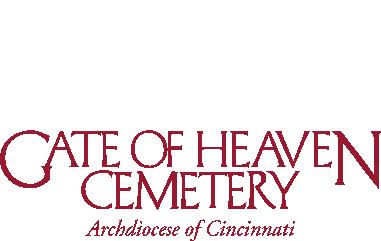
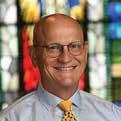
Maria Josefa was born in Spain during 1842. Her father died when she was 7, so her mother oversaw her spiritual care until she was sent to live with relatives in Madrid at age 15. Upon returning home, she told her mother, “I was born with a religious vocation,” and she wanted to join a monastery. Joining the Servants of Mary at age 18, Maria eventually discerned that she was not in the right place.
In 1871, Maria established a new religious congregation, the Servants of Jesus of Charity, and took the name María Josefa of the Heart of Jesus. The order’s primary charism was caring for the sick in hospitals and homes, which grew to include care for the elderly, children in child care centers,



In her writings, St. Maria Josefa described her great love for the Eucharist and devotion to the Sacred Heart. After suffering a long period from sickness and being confined, she passed away in 1912.
At the time of her death, there were 43 religious houses and more than 1,000 Sisters of the Servants of Jesus of Charity. Today, 1,050 religious institutes of the Servants of Jesus are present in Spain and other countries, including Italy, France, Portugal, Chile, Argentina, Columbia, Mexico, Ecuador, Peru, Dominican Republic, Paraguay and the Philippines.

Craft Directions











thecatholictelegraph.com/ maria-josefa-craft
Craft Video



thecatholictelegraph.com/ maria-josefa-video
charism charity devotion discern maria josefa monastery sacred heart servants sick spain vocation



“Without the cross we cannot live...”

Archbishop Dennis M. Schnurr presented the 2022 Respect Life Award to Denise “Dennie” Stieritz on Jan. 15. A a longtime volunteer for Dayton Right to Life and educator at Carroll High, Stieritz has impacted thousands of students and adults through her pro-life witness and advocacy.
1 2 3 4


Five Badin High School art students earned awards at the annual “Tomorrow’s Artists Today” exhibition sponsored by the Middletown Arts Center. Flanked by Badin art teachers Michelle Martin-McDulin and Sarah Daniels at left and Mr. Darrell Williams at right, the winners included: freshman Lexi Brecht, junior Emmy Demmel, senior Olivia Blanton, junior Paige Harris and senior Eva Groh. Harris won first place honors in the painting category.
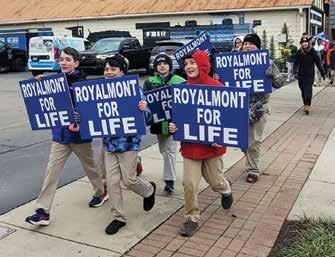

Royalmont Academy elementary students held their annual “Mini March for Life” in downtown Mason while the high school students attended the national March for Life in Washington D.C.

Kindergarten teachers, Deb Timmerman and Robin Caldwell, at St. Remy Church in Russia, OH, taught a unit on the Mass and the priesthood. As part of the lesson, Caldwell shared her youth-sized vestments and Mass kit with the 24 students.

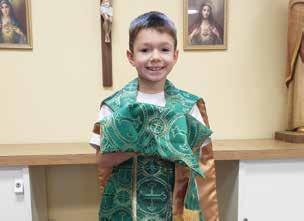

ACROSS
1 “Destroy this temple, and in three days I will ___ it up.”
(Jn. 2:19)
6 Xanadu’s river
10 Gusto
14 Aquatic mammal
15 Rake
16 Alcohol prohibitors (abbr.)
sacrament invalid
64 Empty the truck 68 Makes a doily
69 Fine and delicate
71 Arm joint
72 Space
73 Zeus took away her wings
74 “___ Regina”
75 Ball used for dorm hoops
Directors:
29 English public school
30 “___ grip!”
31 Her tomb was the first thing bought in the Bible
33 OT prophetic book
36 Bell-shaped flower
38 An evangelist
39 Monk called “The Father of English History”
40 Having wings
42 Name of the Rose author
44 A jewel
47 “___ the fatted calf”
49 Serious in intention
52 Catholic university in Texas
54 Underground room
55 “I have observed ___ fall like lightning from the sky.” (Lk 10:18)
56 Trap
57 “___ through the narrow gate” (Mt 7:13)
59 Long
62 Mil. branch
63 701, to Cato
65 Ready, willing and ___
66 The Spirit descended on Jesus as this
67 Female sheep
A Catholic familyowned funeral home since 1877 513.891.8373

A Catholic Family Owned Funeral Home –Since 1877 513-891-8373



GERRY KELLY FRITSCH
Traditional Irish Bagpiper gfritsch48@zoomtown.com cincinnatipiper.com
513.404.0049
513-469-9345
Family-owned & operated since 1912
It was a Tuesday night after a long day of school and softball practice. I still wasn’t sure what this XLT thing was that my best friend had invited me to, but I agreed to check it out. I don’t remember anything about the talk, but I do remember that moment, during Eucharistic Adoration, as the band played, “Amazing love, how could it be, that you my king would die for me?” That was when I realized who was before me: Jesus. It changed everything.
Since that night over 20 years ago, my faith journey has taken many exciting twists and turns, including presently serving as the Managing Director for Parish Evangelization for the Archdiocese of Cincinnati. I have come to know more about evangelization and discipleship in the last few years and given countless presentations and workshops to parish staff and volunteers on the topic.
There is a lot that could be said about evangelization, but I believe the heart of it is this: “We love because He first loved us” (1 Jn. 4: 19). When we encounter a love that is lifechanging and transformative, that is exciting and joyful; we want to share that love with everyone. Just think about the last wedding you attended or newborn baby you met. True love invites others into it, to witness and to participate.
The work of sharing the Gospel is no different. When we encounter Jesus’ love, the love that gives us our identity as beloved sons and daughters, we have no other option than to share it with everyone. We want others to know and experience Jesus’ unconditional love. We see this in the Gospels: the woman at the well experiences Jesus’ love and returns to the village to tell everyone about Him; the disciples on the road to Emmaus, who left in the middle of the night to tell the others about the Resurrected Jesus; and Mary Magdalene met Jesus in the garden on Easter Sunday morning then raced to the Upper Room to tell the Apostles.
Evangelization, the proclamation of the Gospel, can only begin after we encounter Jesus’ love that changes everything within us. How can we encounter this “amazing love,” and share it with others? The methods vary with every person, because Jesus loves each of us uniquely; but we could start with the following:
Prayer & Sacraments. Prayer is required to keep us connected to the One who first loved us, who gives us the grace to evangelize others. Commit to a daily prayer life. Pray Lectio Divina with Scripture. Attend daily Mass and Adoration. Make Confession frequently.
Accompaniment. We are not called to evangelize everyone, and sometimes those we want to evangelize are better evangelized by others. Ask the Lord in prayer to identify one to three people he wants you to intentionally accompany: Build relationships, share a meal, check in sometimes to see how they’re doing and ask if you can pray for and with them.
Discern Your Gifts. The Lord gave each of us unique gifts to build the kingdom and evangelize others. Pray through the following questions to discern what gifts God has given you: What makes you come alive? When have you received positive feedback from family and friends? What is a need or problem in the world that fires you up?
The Holy Spirit is the primary agent of evangelization. Let us entrust our work to Him.
CHRISTEN AQUINO
has over 10 years’ experience working with youth, young adults and adults in both Atlanta and Dayton. She served as the Director for Parish Evangelization for the Archdioceses of Cincinnati for the past three years. Christen now serves as the Director of Mission and Youth at Our Lady of Light Family in Centerville.

It begins with a review of your current loans and credit cards. After that, we work together to determine the best ways we can help you get out of debt quickly. It ends with your financial freedom. It’s THAT easy!


